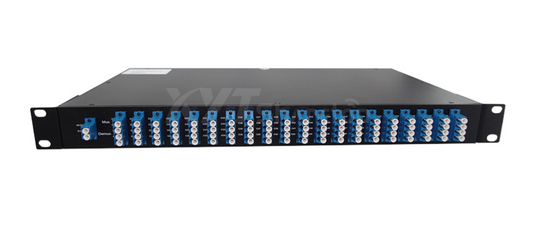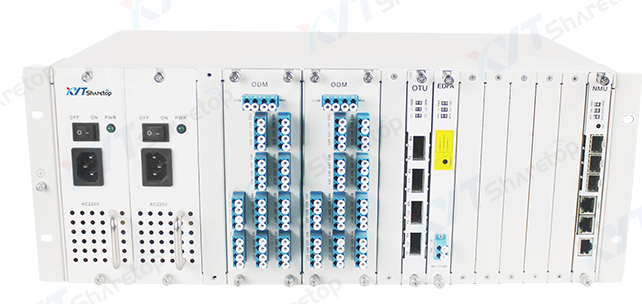Traditionally, data centers have been seen as separate facilities that do not provide companies with much flexibility. If a company wants to expand its data capabilities, it must invest in the data center to obtain more server space, but this does not solve the security problem because all data is stored in one location. With the rapid development of telecommunications, DWDM technology can be used to connect two or more data centers in a general and cost-effective way.

As the size and number of companies choosing to host their information in the data center continue to grow, the demand for stronger functionality and higher bandwidth is also growing. Data centers can host data from large companies such as Google and assets of small companies, which means that they must meet the needs of small enterprises that need 1gbe or 10GbE connections and multinational companies that need 100gbe or even 400gbe connections.
They also need to be geographically interconnected to minimize the risk of external threats to customer networks and improve their backup capabilities. Strong encryption protocols with strict accessibility rules are also needed to avoid costly data disclosure.
In response to the company's demand for capacity, distance and security, data center operators can use wavelength division multiplexing (WDM) technology, which allows the data center to virtually increase its existing optical fiber backbone infrastructure and meet customers' demand for bandwidth.
CWDM or DWDM?

The traditional solution used in the data center is coarse wavelength division multiplexing (CWDM), which is a convenient and low-cost technology, but only 18 channels are connected through optical fiber pairs. Although the cost of dense wavelength division multiplexer (DWDM) is slightly more expensive than CWDM, it has a larger capacity of 96 channels. At present, DWDM is becoming more and more popular.
DWDM connection can be amplified by optical amplifier, so it can be used to transmit data over longer distances (even thousands of kilometers). DWDM can support 40 to 96 independent wavelengths. In order to support 48 channels in 100 GHz grid, the interval is 0.8 nm, while 96 channels are obtained for 50 GHz grid, the interval is 0.4 nm. This means that a large amount of data can be transmitted through a single fiber.
Another advantage of DWDM is that the network transmits at different wavelengths and the channels will not interfere with each other, which means that they can use different data formats and transmit at different data rates. This capability is critical to maintaining data integrity and ensuring any security related partitions with multiple tenants in the same data center.
For these reasons, DWDM technology is a more suitable solution for long-distance high-capacity data transmission and connection. It is also useful for densely populated data centers, especially the dense multi tenant space of super large-scale cloud service providers or hosting providers.
Data center interconnection
Data center interconnection (DCI) is a technology that uses packet optical connection to connect two or more data centers together over short, medium and long distances.
In order to implement an effective DCI strategy, companies can choose to use multiplexed repeaters. However, for large companies that need to provide more than 100g connections at a reasonable cost, a more appropriate option is to use the qsfp + / qsfp28 port. By installing transmission solutions directly in such devices, users can eliminate additional hardware and significantly reduce implementation and network maintenance costs.
The qsfp28 DWDM solution relies on advanced pulse amplitude modulation to provide up to 4 TB / s capacity on one fiber and facilitate connectivity to data centers even 120 kilometers away. One advantage of these solutions is that the modules are installed directly in the network equipment, and their signals are transmitted directly to the multiplexer. Because of this approach, companies can obtain economical but scalable solutions.
The whole solution needs suitable multiplexers, optical amplifiers and dispersion compensators. This is a one-time investment in starting the first 100 Gbps transmission phase. Compared with the use of dedicated transmission, the application of qsfp28 DWDM transceiver directly installed in network equipment can save users 58% to 67% of the total cost of ownership (TCO) of the transceiver. Solutions for data centers up to 80 kilometers away. This ensures the company's rapid return on investment and provides them with the possibility of expanding their scale. For example, to start 100 Gbps transmission for another 39 channels, data center managers only need to use the correct optical module.
The qsfp + / qsfp28 port not only occupies the least rack space, thus reducing the total cost of the transmission solution, but also reduces the power consumption per transmission bit. This makes it ideal for connecting data centers up to 120 kilometers, while maintaining sustainable installation and deployment.
Modern data centers need modern advanced solutions. They are no longer just seen as places to store data, but increasingly as a viable solution to expand their business and improve customer satisfaction by providing them with secure and easy access to their data. DWDM is an ideal technology for connecting data centers and responding to corporate needs. Higher speed, larger channel capacity and longer distance make DWDM the preferred technology for modern enterprises.
XTY DWDM (dense wavelength division multiplexing) equipment system has a variety of networking modes, which can form point-to-point, chain, ring, single fiber bidirectional, one-to-many and other network connections. The number of service channels can reach 96 waves, the maximum transmission rate of single wavelength is 200gbit / s, and the maximum transmission capacity of the system can reach 1920gbit. It has the characteristics of high speed and large capacity. You can gradually increase the wavelength to expand the capacity according to the actual business volume, which is very economical and flexible. DWDM (dense wavelength division multiplexing) system technology can make full use of the huge bandwidth resources of optical fiber and increase the transmission capacity of an optical fiber by dozens or even hundreds of times compared with single wavelength transmission. It is the best solution to deal with the shortage of optical cable resources at present.

Xyt-1600 series wavelength division transmission platform
In addition to the advantages of large capacity and flexible networking,XYT DWDM transmission system also has 1 + 1 optical protection function and 1 + 1 power thermal redundancy backup to provide safe and stable transmission lines. At the same time, it also has flexible network management configuration, adopts SNMP based graphical interface, and can support in band and out of band management. The network management system adopts embedded operating system, with real-time monitoring function, flexible and diverse management methods, friendly man-machine interface and convenient and reliable use experience.

隐私保护 |
法律声明 |
在线留言 |
网站导航 |
网站地图 |
文档下载 | 咨询热线:0755-27524036 |
订阅
深圳纤亿通科技有限公司版权所有 转载必究 Copyright 2010-2019 poptimes CO.,Ltd. All rights reserved.
备案号:粤ICP备14020946号
友情链接: 光创未来| fiber168| 纤亿通光源放大器网站| 纤亿通光模块网站| 纤亿通保偏无源器件网站| 纤亿通OTN网站

